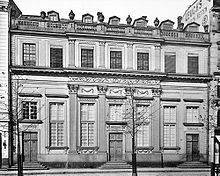Goetheplatz (Frankfurt am Main)
| goetheplatz | |
|---|---|
| Place in Frankfurt am Main | |
 View from Rathenauplatz over Goetheplatz to Roßmarkt |
|
| Basic data | |
| place | Frankfurt am Main |
| District | Downtown |
| Created | middle Ages |
| Newly designed | 1844, 1952, 2008 |
| Confluent streets | Steinweg , Goethestrasse , Junghofstrasse |
| Buildings | French Reformed Church (1789–1944), Goethe Monument (1844) |
| use | |
| Space design | Pedestrian zone |
| Technical specifications | |
| Square area | 4000 m² |
The Goetheplatz is a square in the city center of Frankfurt am Main . Like the Rathenauplatz , which adjoins in the north, it was originally part of the Roßmarkt, which was laid out in the Middle Ages . It received its name in 1844 with the setting up of Goethe monument by Ludwig Schwanthaler .
location
The Goetheplatz is, except for the carriageway running on its west side, a pedestrian zone. The Steinweg flows into the square from the east , and Goethestraße and Junghofstraße from the west . The square was originally narrower than it is today. A row of similar row houses , the so-called New Houses , formed its eastern edge . The council had it built in 1666 to sell the pottery stalls that had previously been set up here from the Kannenbäckerland and Franconia . Since then, only the narrow Töpfgasse between Steinweg and Roßmarkt has been a reminder of the trade .
history
On the western edge of the square stood the French Reformed Church , built between 1788 and 1792 , one of the most important early classical buildings in Frankfurt. It was probably designed by Nicolas Alexandre Salins de Montfort . The city council only permitted its construction on the condition that it did not have its own square or tower and that it should not be recognizable as a church from the outside, but should blend in harmoniously with the adjacent house fronts. On March 28, 1837, the composer Felix Mendelssohn Bartholdy and Cécile Charlotte married Sophie Jeanrenaud , who came from an influential Huguenot family, in the church. Cecile's father was pastor of the French Reformed congregation from 1810 to 1817, while Felix's father Abraham Mendelssohn Bartholdy was baptized in the church in 1822 .
The church burned down during the air raids on Frankfurt am Main , and some of the new houses were badly damaged. After the war, the completely rebuildable ruins were demolished and replaced by commercial buildings in the simple style of the reconstruction period of the 1950s. The narrow Töpfgasse disappeared and Goetheplatz was widened. The Goethe monument, damaged in the war, was restored and moved to the Gallus complex in 1952 .
From 1872 to 1954, tracks of the municipal tram , which ran the lines from Bockenheim to Zeil , ran across the square . In the course of a change in the route at the main guard, the tracks at Goetheplatz ran from 1954 in a north-south direction. In 1986 the tram was shut down as part of the rail-free city center concept .
At the beginning of the 21st century the square was redesigned and a multi-storey underground car park was built under the square. The Goethe Memorial has been in its original location since 2008.
Pomodoro fountain
In 1983 the astronomical fountain by Giò Pomodoro was installed on the Steinweg-Goethestrasse axis . It consisted of a 7 meter high, as the gnomon of a sundial acting obelisk and one, a smaller two water areas and a larger square, split fountain basin. On the day of the summer solstice at astronomical noon , the shadow of the gnomon fell exactly on the dividing line between the two bodies of water. The other days the shadow fell outside the well basin. A straight line in the pavement marked the points that the shadow peak reached in the course of a year. Further markings on the gnomon indicated the equinoxes . A bronze plaque was mounted on the fountain with a verse glorifying the sun from Goethe's ballad Der Müllerin Reue .
In 2004 the fountain was dismantled as part of the redesign of the square. It is currently stored in a municipal depot and is waiting to be moved to another suitable location.
literature
- Fried Lübbecke : The face of the city. Based on Frankfurt plans by Faber, Merian and Delkeskamp 1552–1864 . Waldemar Kramer Verlag, Frankfurt am Main 1983, ISBN 3-7829-0276-9 .
Web links
Individual evidence
- ^ Art in public space
- ^ Frankfurter Brunnen - jewelry and art for streets and squares. ( PDF , approx. 6.46 MB) In: frankfurt.de . Hochbauamt Frankfurt, December 1985, p. 12 , archived from the original ; accessed on February 25, 2020 .
Coordinates: 50 ° 6 ′ 47 " N , 8 ° 40 ′ 36" E
